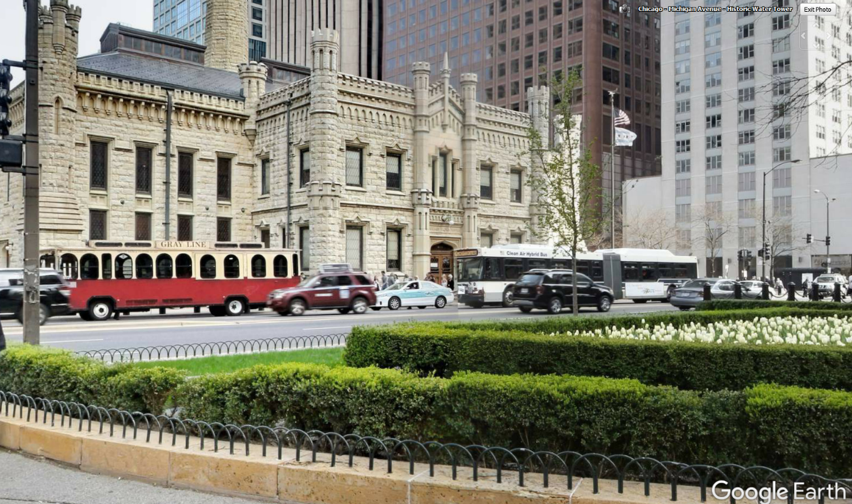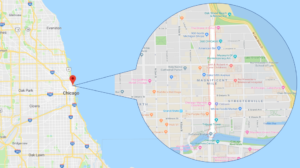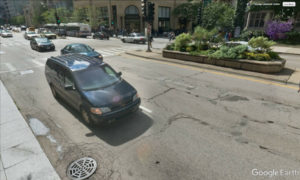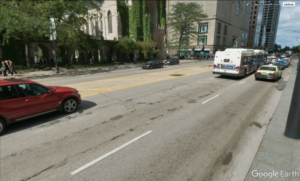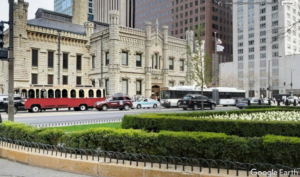It’s 2011, and the city of Chicago has a serious problem. Construction season is in full swing, summer is drawing to a close, and one of the most famous roads in the city needs to be repaved.
North Michigan Avenue, colloquially known as the “Magnificent Mile,” is the city’s premier commercial district. Akin to Rodeo Drive in Beverly Hills or Fifth Avenue in NYC, the Mile is home to iconic brands like Saks Fifth Avenue, Tiffany and Co., and Burberry. It is also a heavily trafficked street- it’s a main thoroughfare for the downtown area with no fewer than 11 bus lines running through it.
High Stakes, Fast-Approaching Deadline, Limited Budget
Every year, millions of tourists visit Chicago and spend tens of billions of dollars in the city. As the home of many high-end residences, hotels, restaurants, and businesses, the Mile is a hotspot for tourist activity year-round. During the holiday season it attracts even more tourists for both shopping and for the annual Lights Festival.
The timeline for getting this project done was unusually short. The Mile project was not on CDOT’s list of projects at the beginning of 2011- and it wasn’t approved until summer, when construction season had already begun. The project was approved in August, permits were granted in September, and work was scheduled to be finished in November.
The budget for this project was set at $1 million. Considering that the Magnificent Mile is a 6 lane, 12-block stretch of road, that doesn’t leave a lot of room for error. CDOT was going to have to be creative to stay in budget and finish the project in time for the holiday rush.
Complications Arise
Typically projects like this are pretty cut and dry: the road shuts down, the top layer of pavement is milled (removed), the road is repaved, then it’s reopened.
But the Mile is home to many residences, hotels, and businesses. It couldn’t be shut down completely at any point in time- doing so would be a huge disruption for the people who live, work, and do business on the Mile. Paving had to be carried out in such a way that would protect local businesses and residents. This meant a modified construction schedule, with fewer hours to get the job done.
Another complication arose when a survey of the existing road was completed. An examination of the pavement revealed that there were extreme inconsistencies in the subbase. The paving mix that they originally planned on using wouldn’t work well with a subbase that was so irregular. This, combined with a short timeline and limited budget, motivated the city to look for an alternative solution.
One Man’s Trash Is Another’s Pavement
CDOT worked with STATE Testing, LLC to help design a mix that could be used on this project. They chose a stone matrix asphalt (SMA). SMA is beneficial for two reasons: one, because SMA is famous for its strength and durability; two, because the asphalt binder content in SMA is high, making it possible to incorporate more recycled materials into the binder. This would result in a final product that would be tough and cost-effective. STATE collaborated with Arrow Road Construction to develop the mix that was eventually used on the Magnificent Mile. Here’s their recipe:
- Quartzite aggregate served as the main aggregate, giving the mix strength, low absorption, and high friction.
- 24 truckloads of reclaimed asphalt pavement (RAP) were fractionated, which allowed it act as the fine aggregate in the mix.
- Recycled asphalt shingles from the roofs of 130 houses.
- PG 58-26 for the base liquid.
- Recycled ground tire rubber from 2,200 discarded passenger car tires. This rubber was used to modify the asphalt binder, making the final binder grade equivalent to a polymer-modified PG 70-28.
Bold but Not Blind
Paving using recycled materials has been the subject of research for many years. RAP, asphalt shingles, glass, car tires, plastic bottles, and other materials have been broken down and incorporated into pavements all across the country. The environmental benefits, effectiveness, and cost savings are just too good to pass up.
The Illinois DOT has also been working on pursuing paving technology that’s more green for years. According to a 2018 report, IDOT’s goal is “to reduce the carbon footprint and achieve cost savings through the use of recycled materials in asphalt paving projects.” And they are making progress towards that goal: in 2016 alone, Illinois used nearly 1.8 million tons of recycled materials in their projects, and they plan on growing their use of recycled materials in the future.
Illinois isn’t the only state picking up on the benefits of recycled roads. The use of RAP in paving projects is on the rise nationwide: according to this 2018 NAPA report, over 78 million tons of recycled material were used in asphalt paving mixtures in 2017. RAP was responsible for conserving 3.8 million tons of asphalt binder and replacing 72 million tons of virgin aggregate. These materials would otherwise be dumped into landfills, taking up tens of millions of cubic feet. And the quality of the pavement doesn’t suffer: there are currently over three decades of research demonstrating that pavements made with RAP “offer the same durability as pavements constructed with virgin materials” (Source: NAPA).
Other materials can be recycled into pavement as well. STATE Testing, the company that helped develop the mix for the Mile project, has been working on developing asphalt projects that incorporated ground-tire rubber (GTR) since the early 2000s. One thousand tires are recycled for every one lane mile of asphalt (assuming a one-inch lift).
The benefits are hard to ignore, but it’s important to remember that recycled materials aren’t a magical cure-all. There are potential downsides to using them, and they need to be used wisely. Some recycled materials tend to become brittle over time, which can cause cracking and aging to happen faster than normal. There is ongoing research on how to incorporate recycled materials into pavement without sacrificing pavement quality (and with promising results- see here, here, here, and here).
Environmentally Friendly and Economically Savvy
One reason agencies are choosing recycled materials is for the substantial cost savings they bring. It isn’t east to quantify what the exact cost savings are, and official agency estimates vary. But it’s pretty simple to see how quickly the savings add up if we just break it down:
Let’s say asphalt shingles are being upcycled into asphalt binder for a paving project. The US RAS Association Midwest estimates that recycled shingles are about $550 cheaper per ton than virgin liquid asphalt (just $50 opposed to $600 per ton).
Assuming that liquid asphalt is 5% of the total HMA mix, a one-mile, two-lane road that is paved with a two-inch lift needs nearly 80 tons of liquid asphalt. Using the cost saving estimates above, paving this road with new asphalt binder would cost $48,000 while using just recycled shingles would cost only $4,000. Now, the binder used in a mix would contain a blend of both recycled and virgin asphalt, so in practice it would cost a little more than $4,000 to supply the asphalt for this hypothetical road. But still, the cost difference between these two sources of material are drastic, and those savings are a hard thing to pass up.
These budgetary benefits did not go unnoticed by the city of Chicago. Gabe Klein, who was the commissioner of CDOT at the time, said, “We didn’t do it just to be hippy dippy and to say, ‘Hey this is a recycled street… It was dramatically cheaper. It was like 40 percent cheaper. It’s a higher quality street. It’s also quieter because it’s got rubber so you don’t hear the buses going by as much.”
Moving Forward with the Plan
Overall the Mile mix contained about 45% recycled content. This is an unusually high percentage of recycled materials to include in a pavement. To ensure that this mix would perform as planned, Arrow Road Construction did rigorous quality testing throughout the process of making the mix. The City of Chicago did their own testing, and the results had to be consistent between the two groups before paving could proceed.
Once the quality testing results were acceptable, the paving operation began. Milling was completed on October 19, less than a month after the initial permits and adjustments were made. To protect local businesses and residents from inordinate disruption, the construction schedule was limited. Crews were onsite paving from 8:00 PM to 6:00 AM, and no work at all was done between Friday at 3:00 PM and Monday at 9:00 AM. This helped limit the negative impact of construction on traffic and normal business operations on the Mile.
Just three days later, on October 22, paving was done. By November 14 all final loop detectors and striping had been put in place, and the Magnificent Mile was fully open to traffic once more.
The National Asphalt Paving Association (NAPA) was so impressed with CDOT’s work on the Mile that they invented a new award to commend them for it. Margaret B. Cervarich, NAPA’s association’s vice president for communications and public affairs, applauded CDOT for their vision on this project, saying: “They dared to put a high percentage of recycled materials into the SMA (stone-matrix asphalt mix), the premium asphalt surfacing. SMA is tough stuff, but you have to get it just right. Therefore using reclaimed asphalt pavement, PLUS recycled asphalt shingles, PLUS ground tire rubber was a bold move.”
The Environmental Leadership Award was accepted by Gabe Klein on July 17, 2012. Klein, along with Jay Behnke of STATE Testing and John Healy of Arrow Construction, spoke about the project at a NAPA event in July 2012.
2019 Update: A Magnificent Legacy
Based on these images from Google Earth and this 2014 panorama, it looks like the Mile is holding up reasonably well. There are definitely signs of normal wear and tear– even recycled roads don’t last forever, especially not in a place with a freeze-thaw cycle like Chicago. There’s evidence of some crack sealing that was done in the 2014 photo, and more recent photos show a bit of fatigue cracking. But on the whole, the images show a road that is in pretty good shape.
The environmental benefits, quality improvements, and enormous cost savings of recycled roads make them an attractive option for many agencies. In the years since the Mile was repaved, there has been even more research conducted on how to optimally integrate RAP, shingles, and other materials into pavements. Special attention is being given to the impact of recycled materials on life cycle and the impact on quality that recycled materials have.
Both Chicago and the Illinois DOTs have made concentrated efforts since 2011 to continue expanding the use of recycled materials in their paving projects. Many roads around the state, including a section of I-80 in Will County, Harlem Avenue in Cook County, and even a runway at O’Hare have been repaved using recycled materials.
The use of recycled materials is just one way our roads are getting smarter. In the coming months we’ll be highlighting projects like the Magnificent Mile that successfully address transportation and asphalt challenges.
Follow us on LinkedIn, Facebook, and Twitter to stay up-to-date as we bring you the latest stories of the bold, the brilliant, and the budget-conscious.
References:
- Behnke, J., Healy, J., Klein, G., & Williams, C. (2012, July 17). Chicago’s Magnificent Green Mile. Lecture presented at Magnificent Opportunities for Asphalt: Overcoming Challenges, Delivering Solutions, Chicago. http://asphaltpavement.org/index.php?option=com_content&view=article&id=750:plenary-sessions&catid=203:2012-midyear&Itemid=100003
- Bloom, E. F., Ponte, K. D., Natarajan, B. M., Ahlman, A. P., Edil, T. B., & Whited, G. (2016). State DOT Life Cycle Benefits of Recycled Material in Road Construction. Geo-Chicago 2016. doi:10.1061/9780784480120.070
- (2012, July 17). CDOT Recognized for Environmental Leadership for Innovative Use of Recycled Materials in Michigan Avenue Repaving Project. Retrieved from https://www.chicago.gov/city/en/depts/cdot/provdrs/street/news/2012/jul/cdot_recognized_forenvironmentalleadershipforinnovativeuseofrecy.html
- Cleaver, L. (2012, September 26). Producing an Environmentally Friendly Pavement. Retrieved from https://www.forconstructionpros.com/asphalt/article/10785070/producing-an-environmentally-friendly-asphalt-pavement
- Farina, A., Zanetti, M. C., Santagata, E., & Blengini, G. A. (2017). Life cycle assessment applied to bituminous mixtures containing recycled materials: Crumb rubber and reclaimed asphalt pavement. Resources, Conservation and Recycling,117(Part B), 204-212. doi: https://doi.org/10.1016/j.resconrec.2016.10.015
- Griffiths, C. T., & Krstulovich, J. M., Jr. (2002). Utilization of Recycled Materials in Illinois Highway Construction. Physical Research Report No. 142. Retrieved from http://www.idot.illinois.gov/assets/uploads/files/transportation-system/research/physical-research-reports/142.pdf
- Hilkevitch, J. (2014, June 30). Getting Around: Old shingles get new life on O’Hare runway. Retrieved from https://www.chicagotribune.com/news/columnists/ct-ohare-recycled-runways-getting-around-met-0630-20140630-column.html
- Hinz, G. (2017, January 05). City says tourism in 2016 hit record: 54.1 million visitors. Retrieved from https://www.chicagobusiness.com/article/20170105/BLOGS02/170109935/chicago-officials-say-tourism-in-2016-hit-record-54-1-million-visitors
- I, W. (2014, August 8). Chicago Water Tower[Photograph]. Chicago, IL. https://www.360cities.net/ge_image/watertower?utm_source=google_earth&utm_medium=all_images
- Lender, S. (2012). Arrow Gives Chicago Magnificent Green Asphalt. Asphalt Pro,50-51. Retrieved from https://issuu.com/businesstimescompany/docs/apro-1208.
- Marks, H. (2017). Reclaimed Asphalt Pavement (RAP): Stockpile Emissions and Leachate (Rep. No. 8.1). Landham, MD: National Asphalt Paving Assoication. Retrieved from https://www.asphaltpavement.org/images/stories/SR-190revised.pdf.
- McMahon, J. (2012, July 31). Taking Recycling To The Street: Chicago Recycles Michigan Ave. Retrieved from https://www.forbes.com/sites/jeffmcmahon/2012/07/31/taking-recycling-to-the-street-chicago-recycles-michigan-avenue/#21b229244c89
- Pavement Interactive. (n.d.). Recycled HMA. Retrieved from https://www.pavementinteractive.org/reference-desk/pavement-types-and-history/pavement-types/recycled-hma/
- Rath, P. (2017). Performance analysis of asphalt mixtures modified with ground tire rubber and recycled materials(Unpublished master’s thesis, 2017). University of Illinois at Urbana-Champaign. Retrieved from http://hdl.handle.net/2142/99127
- Rose Paving. (2017, October 08). City of Chicago Honored With Environmental Leadership Award. Retrieved from https://www.rosepaving.com/press/city-of-chicago-honored-with-environmental-leadership-award/
- Saberi, F., Fakhri, M., & Azami, A. (2017). Evaluation of warm mix asphalt mixtures containing reclaimed asphalt pavement and crumb rubber. Journal of Cleaner Production,165, 1125-1132. Doi: https://doi.org/10.1016/j.jclepro.2017.07.079
- Sharma, B. K. (n.d.). Advancing Use of Recycled Material in Asphalt. Retrieved from https://www.istc.illinois.edu/research/resource_recovery/recycled_material_asphalt
- Smith, T. J. (2014, November/December). O’Hare Recycles Old Roofing Shingles into New Runway Pavement. Retrieved from https://airportimprovement.com/article/ohare-recycles-old-roofing-shingles-new-runway-pavement

